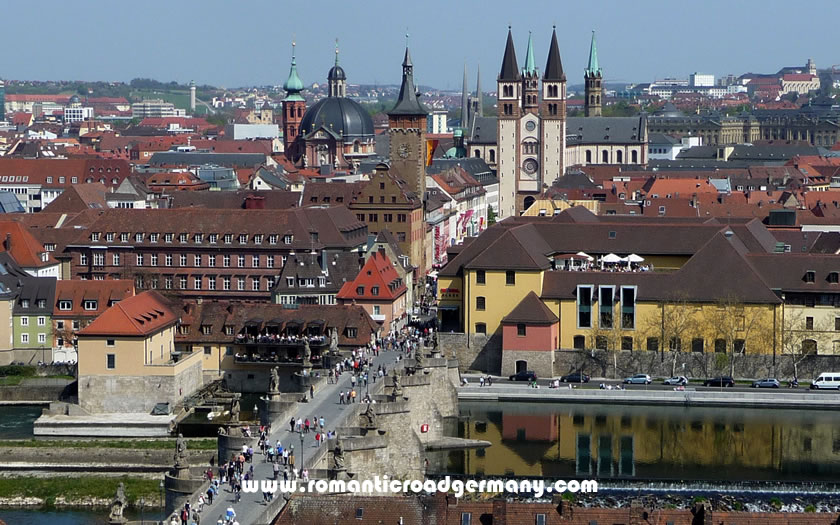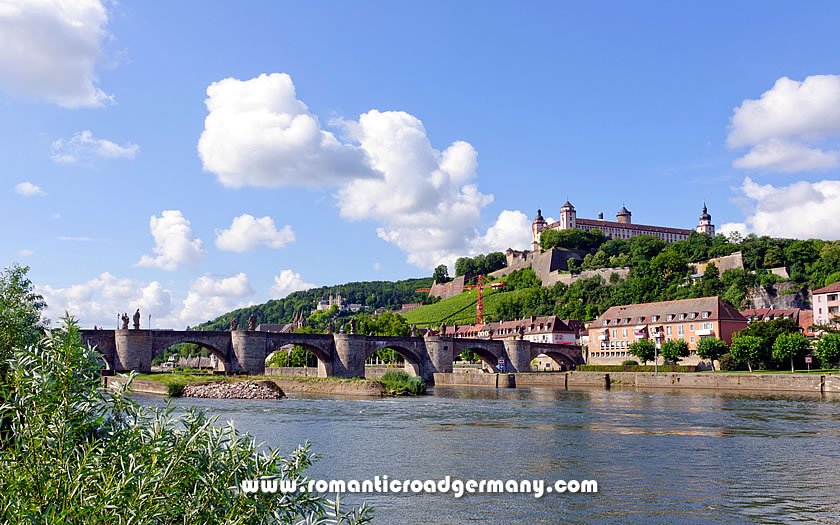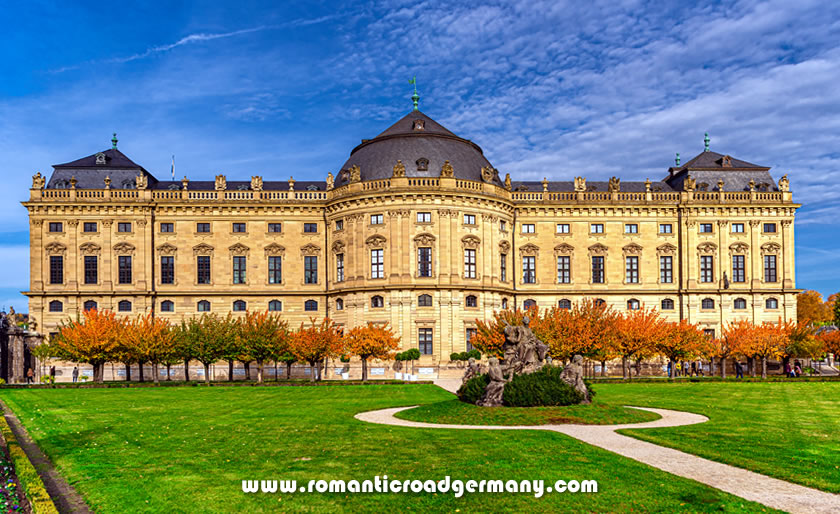

Würzburg is often where a visitor decides to start their tour of the Romantic Road route through southern Germany - and it is a fine introduction to the trip.
The city itself is set in a beautiful hilly location on a river and possesses a wealth of history, as well playing host to a UNESCO World Heritage site in the Residence palace.
It is also smack in the middle of one of Germany's biggest wine-producing areas and has superb connections to other parts of the country.

Würzburg is located in the central part of Bavaria near the western edge of the state. It is one of the main cities in the Franconia region, which covers much of northern Bavaria, as well as smaller parts of Baden-Württemberg, Thuringia and Hesse.
The original name 'Virteburh' is first mentioned in the 8th century. The last part of the name refers to fortifications (probably on the Marienberg) and the first part could either be a reference to herbs (the present-day 'Würze' means 'spices' or 'flavouring') or to a Celtic goddess who was worshipped nearby (stemming from the Celtic for 'virgin').
The umlaut over the letter U makes the vowel longer and is sometimes written as 'ue'. Phonetically, something like 'voortsburg' would be fairly close.
Bavaria may be a region famous for its beer, but Würzburg is the centre of the Fränkisches Weinland (Franconian Wine Region), which is famous for its red and white wines in their special round bottles.
Würzburg is located on the Main river. which flows through Frankfurt am Main and then joins the Rhine near Mainz.
For the start of the Romantic Road there are three airports which are relatively close to Würzburg: Frankfurt, Stuttgart and Nuremberg.
Distance to Nuremberg Airport: 108km
Distance to
Frankfurt Airport: 124km
Distance to Stuttgart Airport: 165km
Distance to Memmingen Airport: 241km
Distance to Munich Airport: 270km
The three closest airports have a good mixed of scheduled, low-fare and charter carriers, while the second three may be options for those whose choice of flights is dictated by international connections.
Würzburg's main railway station is situated to the north of the city centre. Würzburg is a pretty big rail connection for the rest of Germany and it is easy to find connections to other German provinces or European countries.
Würzburg is the start of most people's journey down the Romantic Road - and so it's a good idea to get the trip off on a good footing by staying in some good hotel accommodation in the city.
There is certainly enough to choose from - whether you are looking for the action of the city centre or something a little quieter out in the hills and vineyards around the old town.
It's a good idea to ensure you are booking a hotel in advance in busy periods. Würzburg is not only a favourite with tourists, but as a busy regional centre it also has its own conferences, trade fairs and seasonal festivals.
CIf you know when you are planning to go but haven't decided on accommodation, then use the map below to get an idea of which properties are available and to compare prices during the period you wish to travel.
Enter your proposed dates and use the '+' to zoom in on a location and reveal more properties. Click on the price above a property to see more information.
(Please note that this selection will also include some guesthouses, pensions and self-catering apartments for those who are interested in that form of accommodation!)
If you know when you are planning to go but haven't decided on accommodation, then use the searchbox below to get an idea of which properties are available and to compare prices during the period you wish to travel.
The first fortifications on the hill where the Marienberg Fortress now stands date from a thousand years before Christ, when the Celts built one of their formidable ring fortresses on this prime defensive position.
The city itself grew in the 7th century as it became the seat of a Franconian lord and, eventually, a religious centre and a place of pilgrimage for the martyred St Kilian.
In the 12th century the first of the powerful bishops was elevated to the worldly rank of Prince Bishop (actually "Duke of Western Franconia") - an important step as that meant that church donations and tithes as well as regional taxes all flowed into the bishops' administration.
Würzburg had grown so powerful that it was considered the unofficial capital of the Holy Roman Empire - the wedding of Emperor Frederick I was held here, for example.

The fortress on the Marienberg was important to the Prince Bishops not only for its prominence but also for its defensive qualities. The citizens of Würzburg, possibly fed up with the taxes, declared themselves for the peasants' side in the Peasants' War of the 16th century.
Through various wars and fires, both the city and the fortress were continually expanded and provided with stronger defences. In the 18th century, the age of absolute rulers who brought a relative stability to they lands the controlled, the Prince Bishops felt secure - and rich - enough to build themselves a palace befitting their position in the city down below. The Residence was finished at the end of 1744.
Eventually the Napoleonic Wars caused the downfall of the Prince Bishops and the city passed under the control of Bavaria.
The city suffered appalling damage at the end of the Second World War. Although filled with refugees and injured (it was considered a "hospital city") a massive bombing raid was carried out on the city on March 16, 1945. Within 17 minutes 87% of the city was destroyed in a massive firestorm which could be seen from over 230km away.
The city became known as the "Grab am Main" ("the grave on the River Main") and the subsequent American occupation even put forwards proposals to build a new city in another location and to keep the ruins as a memorial (proposals which were heartily rejected by the remaining population who concentrated in the post-war decades on the reconstruction of the Würzburg of their memories).
The Würzburg Residence is the stunning former home of the Prince Bishops. Located on the edge of the inner city, the Baroque palace was built in the 18th century under the stewardship of Balthasar Neumann but incorporated art and decoration from different parts of Europe.

The fortress on the other side of the River Main was the previous residence of the Prince-Bishops (in the days where they perhaps needed more personal protection!). Fortified in the days of the Celts, much of the current building dates from the 17th and 18th centuries.
The Cathedral is dedicated to the Irish martyr St Kilian, who met his death here on missionary work. The original cathedral is now thought to have been where the current Neumünster basilica is located - the location of the current cathedral was chosen in the 11th century. The cathedral was badly damaged in aerial bombing that destroyed much of Würzburg at the end of the Second World War. In 1946 much of the remaining building collapsed and reconstruction lasted until the 1960s.
The Neumünster was where the bones of St Kilian and his two assistants
were said to have been "rediscovered" (they had been killed for trying to persuade
the current ruler that his marriage was "unchristian"). During the time of
the closure of the cathedral it served as a replacement and is now officially
the Würzburg parish church.
Website: www.dom-wuerzburg.de
Website: www.neumuenster-wuerzburg.de
The museum in the old renovated granary at the river's edge is dedicated to
modern art from the 19th-21st centuries.
Website: www.kulturspeicher.de
The Würzburg Tourist Office is located in the centre of the
town on the Marienplatz. The yellow building is an old Baroque mansion
called the Falkenhaus and is situated behind the Marienkapelle. It
is open all week in the summer and from Monday-Saturday in the winter.
Website: www.wuerzburg.de